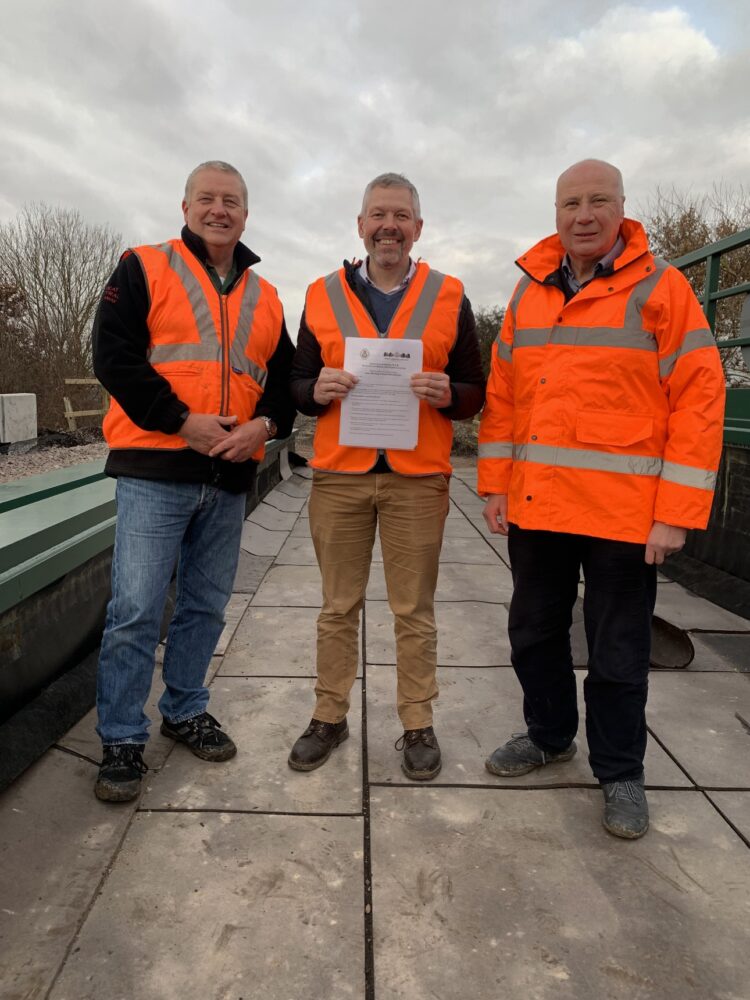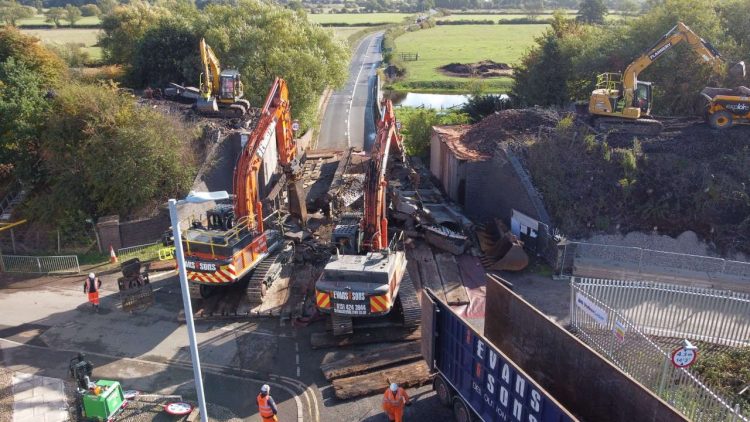The Great Central Railway (GCR) has announced key developments in its ambitious plan to join the two halves of the heritage railway.
GCR’s ‘Reunification’ project will join the Leicestershire and Nottinghamshire sections together. The two were connected until the 1970s, when British Rail separated them by removing old bridges and a long embankment. The local community has wanted the two parts to link up again for a long time. GCR believes that its project to do so is one of the biggest ever undertaken by a heritage railway.

GCR, which celebrated its fiftieth anniversary this year, has raised more than five million pounds since 2013, which it has spent on building, refurbishing and replacing the bridges. Last year, it replaced the bridge over the A60 road in Loughborough. It is now re-laying track on the bridge, to reconnect the Great Central Railway Nottingham to the national rail network.
GCR has now raised a further two million pounds, which will pay for a contract for final design work ahead of the formal planning application, which GCR expects to submit in the coming months. Once planning approval is given, the construction work can restart.
The Directors of each half of railway have signed a memorandum of understanding, setting out how they will work together as the project goes forward, on areas including operating standards to publicity.

Malcolm Holmes, General Manager of the Great Central Railway said, “As we move towards one railway, we need to work ever more closely together. The Memorandum of Understanding is an important step. We’ve also established a project board to guide the rest of the work. It’s made up of rail industry professionals and they are already hard at work. A lot has already been achieved and now we want to complete the job and run the reconnected railway for the benefit of our community and region.”
Andy Fillingham, a director of Great Central Railway Nottingham. “The A60 bridge signifies the rejoining of the two railways. New ballast is on the bridge and soon we’ll have track here again. That will allow us to bring trains into the north from the main line, which in turn delivers economic benefit. Even before the two halves of the Great Central Railway are reunified, it’s another big step forward.”
Richard Patching, chairman of the Great Central Railway said, “We’re looking forward to collaborating ever more closely with our partners, stakeholders and supporters to deliver this shared vision. I remember riding on the line between Leicester and Nottingham in the 1960s. Reunification gathers pace with the signing of the Memorandum Of Understanding. I’d also like to thank everyone who continues to support our fundraising. To pass the £2m mark, all banked for the work ahead is extraordinary. We’re humbled and so excited to keep pushing forward.”






Responses
Well done. An extension to Nottingham Station may not be possible but if not already a consideration a halt in the cutting leading towards Clifton Road may be worthwhile in the short term (15+min walk) or even via the old station drive (20min) to the Farnborough Road tram stop. You May get a grant for encouraging use of public transport as has been have achieved working with local authorities in other parts of the rail network including Nottingham City And County in the past.
The vandalism and land grab of HS2 would not have happened had the Great Central not closed in the first place , or Central railway group’s plan to place freight lorries on trains at Folkestone and use the old GCR route to bring them to the midlands via the old Ashendon junction to Grendon junction connection .. hey how about reopening that one ??
The GCR isn’t a substitute for HS2 because they’re entirely different railways going to different places, but most especially GCR doesn’t go to Birmingham. The GCR doesn’t provide anywhere close to the capacity benefits the full HS2 does. That doesn’t mean it should have been closed, it shouldn’t, but we’d still need HS2.
In my late teens, I used to travel on a slow overnight service from Nottingham to mu job in London, after weekends at home.
The night trains on the lines were comfortable and probably like you I preferred GCR route to Midland mainline
Politics killed a mainline significantly newer and more sustainable than Midland Mainline and the cutting of the GCR route to London has probably been a major contributory factor in the capacity problems of the WCML.
Freight doesn’t always need most direct route but needs route without clearance problems .
The WCML has been adapted as has ECML and GWR mainline to Bristol to the Berne loading gauge for freight and container traffic from ports something which the Great Central line had & the Midland Mainline doesn’t completely have .
Is there any chance that the GCR might one day, sometime, be restored as far south as Banbury? A new alignment needed, in places. Warwickshire is currently a railway desert. West of the WCMLine there are no lines running north-south until Leamington Spa. The East Midlands would become more accessible by rail from places such as Oxford, Reading and Southampton. Our national railway network is too ‘threadbare’.
Great news
Brilliant news.
Its a brilluant thing to achieve. Glad i am a member.
Me too, I feel proud to have put something in to this success story.
What a fantastic achievement by the volunteers why they ever shut this important railway line is beyond me
Economics caused the GC closure after all who travelled on it. Whilst reunification is an amazing project the economics of running a Heritage Railway indicates a viability issue in the medium term. After all the WHR cannot make their line pay unless a number of trains only run part route and that is at over £40 per trip
Maybe, but of much more relevance is that by making changes, the Ff&WHR have made enough operating profit to cover running costs and do substantial infrastructure, locomotive and carriage work. How many other railways have done this? Very few I suspect. For long term sustainability this is essential.
Should never have been closed in the first place
The GCR route was deliberately run down in the early 1960s to justify its eventual closure. It was either the MML or GCR had to be closed (duplicate routes) and, sadly, the GCR was chosen.
Heritage railways depend on plenty of volunteers and, so far, the present GCR is doing OK.
As for the F&WHR, since covid it has tailored its services to meet the demand and, as a result, it is making a profit. More services will be run in future years if the demand is there.
Some other heritage lines with large numbers of paid staff are clearly struggling financially and need to reduce their overheads to match their income.
Fortunately, I can only see the GCR going from strength to strength once reunification is completed.
Remember the GCR was built with a visionary person Edward Watkins and the builders of HS2 should have taken note
Further to my previous comment the GCR was built with Edgar Watkins, a visionary who wanted to build a chanel tunnel in the 19th centuary
Agree with you 100% – lots of other lines shouldn’t have been closed either. It was NOT entirely about running costs – the then transport minister (Ernest Marples) did not like railways. Oh, I nearly forgot – he owned a company that was in the business of broad building.
That isn’t strictly true. When Earnest Marple became minister for transport he sold his shares in the family business to avoid a problem conflict of interest… To his wife! So that was okay, then. ..
Can these guys be put in charge of HS2? They seem to have more business acumen than the government.
Larry, many a true word spoken in jest.
Fantastic news, only hope I’m alive to see this come to pass..!!
One project worth its wait , amazing result always enjoyed a day out on the gcr thanks too the volunteers that help make it a visit to remember , the hotchley hill signal box and rushcliffe halt top restoration extremely attractive as witness the huge number of people views on line. Thanks to all involved
What a fantastic opportunity for the two railways. Joined, they will make a wonderful tourist destination.
I can’t help contrasting how much a heritage can achieve with hardly any money with the millions Network Rail need to spend on the smallest project. I know the requirements for a heritage railway are different to the mainline but a bridge is a bridge and I wonder what the minimum Network Rail has ever spent on the reconstruction of a railway bridge ?
My thoughts exactly…
Good news I used to work in Loughborough and quite frequently travelled to Leicester and beyond and to Nottingham by GCR